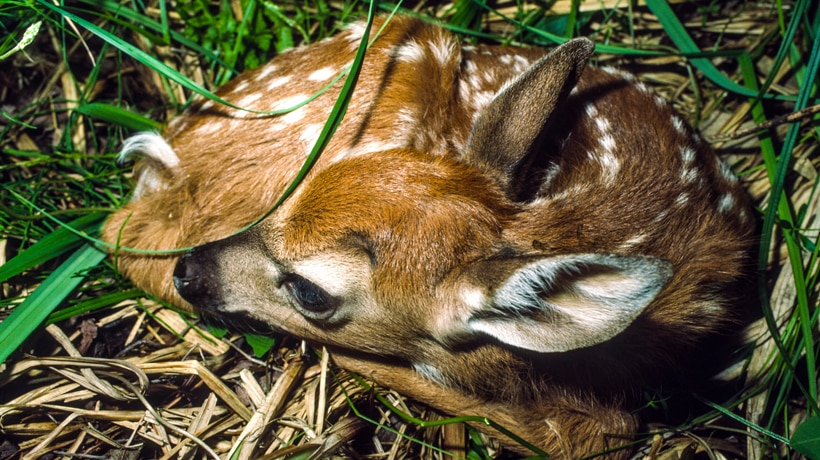Finding a fawn
Fawns are born in late May and early June. If you find a fawn, leave it alone. The animal may be motionless and seem vulnerable, but this is the normal behavior. Even if you see a fawn alone for several days, please leave it alone. The mother is probably feeding or bedded nearby. Does (female deer) visit their fawns to nurse very infrequently, a behavior that helps fawns avoid detection by predators. It is not uncommon for fawns to be left alone for 6-8 hours at a time. Young fawns are usually quite safe when left alone because their color pattern and lack of scent help them to remain undetected.
It is illegal to possess or capture a fawn for any reason. If you think a fawn needs help, contact MassWildlife or the MA Environmental Police first—do not capture or move the animal. If you have taken a fawn into your care, you should immediately return it to where you found it, or to safer cover nearby (within 200 yards). Then, quickly leave the area to ensure the fawn doesn't follow you and so the mother feels safe enough to return. The mother will soon return to nurse the fawn, even after it has been handled by humans. Don't try and feed fawns as they have sensitive stomachs.
If a fawn is visibly injured, call MassWildlife at (508) 389-6300 or the MA Environmental Police at (800) 632-8075. In rare situations where rehabilitation is needed, care for fawns will be coordinated through MassWildlife.
Fawn facts
Many times people try and help fawns as a response to normal fawn behaviors.
These normal behaviors include:
- A fawn that is still and unresponsive. Fawns view humans as predators and will drop their head and freeze to avoid detection.
- A fawn that is crying. Fawns can bleat (vocalize) in a way that sounds like crying if they are disturbed or are trying to locate their mother.
- A fawn that is in your yard. Fawns are commonly found bedded in brushy areas with vegetative cover or even in some grassy areas – even in suburban areas close to homes or near roadways. Their mother felt this was a safe place for the fawn. On occasion, a fawn that has been disturbed may wander into a dangerous area or an area where the mother may not feel comfortable going (e.g., onto a road, near people, into a garage, etc.). Only if a fawn is in real danger should you interfere by moving the fawn to nearby forested or shrubby area where there is thick cover. Then leave quickly, so the fawn does not follow, and don’t linger. The mother will not come if you are nearby.
- A fawn alone for long periods of time. Young fawns remain bedded, alone for most of the day and night. The mother will return several times to nurse briefly. She will not approach if people are nearby.
- A fawn that looks skinny and weak. All fawns appear skinny, but it’s not an indication that they are abandoned or starving. If disturbed, they may also look like they are weak or having trouble walking. Never feed a fawn; their stomachs are sensitive and the food or milk you give them can be very harmful.
These are all normal things for fawns, and while they may be alarming, you do more harm than good attempting to care for a fawn.
